

 The South African
The South African
By Rob Burrett, Zimbabwe
When they first withdrew from Rhodes' Drift after the Blackburn incident in October 1899, the Rhodesian forces had destroyed what stores and fodder they could not remove to prevent them from falling into the hands of the Boers. Now that they had returned, it was necessary to restock this camp under the command of Colonel J A Spreckley, as well as a new position at the MacloutsieLimpopo junction that had been occupied by Major W D Bird. To facilitate this, lieutenant-Colonel HOC Plumer, officer commanding, decided to form an advance depot at a place called Bryce's Store. This lay about 30km south of Fort Tuli, about 10km from the Rhodes' Drift camp. It was also at the junction ot roads leading to the Macloutsie River and Pont Drift. Late in the afternoon of 1 November 1899 a small column of six wagons carrying the necessary supplies set off from Fort Tuli with twenty-four men drawn from both the British South Africa Police (BSAP) and 'A' Troop of the Rhodesia Regiment. They were under the joint command of lieutenants R W Hare (a seconded Imperial Officer, as Quartermaster) and A E Haserick (Rhodesia Regiment) and were accompanied by the Fort Tuli Chaplain, J W Leary.
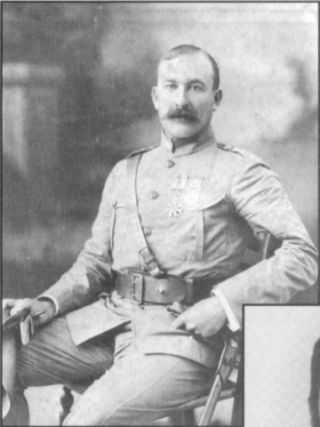
Lt Col J A Spreckley, Officer Commanding 'E' Troop, Rhodesia Regiment.
(By courtesy, National Archives of Zimbabwe).
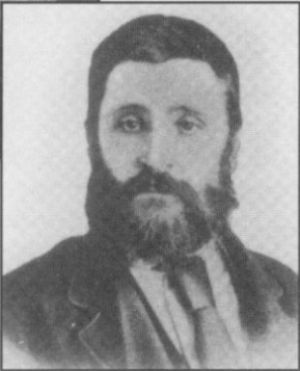
Assistant-General H C J van Rensburg, Zoutpansberg commander.
(Photo: By courtesy, SANMMH).
While this was going on, there had been significant changes in the Boer camp. A select detachment from Waterberg Commando brought renewed enthusiasm to the men of the Zoutpansberg Commando. They had arrived on 31 October and were commanded by Police Commandant S P Grobler - I assume in some way related to Assistant Commandant General F A Grobler who was in command of the burghers on this front. The next day, they were joined by Commandant S Eloff, a grandson of President Kruger. He brought, from Pretoria, a further two Maxims as well as a trained German gunner (probably Baron A F von Dalwig) to operate the large gun which had been delivered by Grobler. Spurred on by the newcomers, the Zoutpansberg commander, Assistant-General H C J van Rensburg, previously so indecisive, was encouraged to act. It was decided that there should be a concerted Boer push into Rhodesian territory, the Rhodes' Drift camp would be destroyed, Fort Tuli captured, and Plumer put to flight.
Accordingly, three to four hundred burghers crossed the Limpopo near Rhodes' Drift early on the morning of 2 November, taking with them the guns. The blustery, drizzly conditions prevalent at the time served to conceal all noise. Once in Rhodesian territory, the Boer force divided into two sections with the aim of outflanking Col Spreckley's camp. One section, under van Rensburg, Grobler and veldcornet J Kelly, together with the Maxims, made their way through the bush to positions to the east of Spreckley's camp. The other section, under Eloff and veldcornets AZA Briel and HW Alberts, taking with them the heavy artillery, moved along the main road to the west. This, incidentally, led to Bryce's Store, although their aim was to secure Spreckley's western flank.
The Rhodesians remained totally oblivious to these developments. Early on the morning of 2 November 1899, Captain Glynn and his 'E' Troop men were reconnoitring the Fort Tuli-Rhodes' Drift telephone line that had been cut yet again. They noted a fair amount of unusual activity in the Boer camp at Pont Drift, but they could not make out what was happening, so they proceeded. However, they soon heard heavy fire coming from the direction of Bryce's Store and Glynn returned to the Rhodes' Drift camp, reporting the matter to his commander, Col Spreckley. The fights at Bryce's Store and at Rhodes' Drift had begun.
Action at Bryce's Store
It would seem that the supply column had reached Bryce's Store around mid-morning, inspanned and that the men had only just settled down to a late breakfast. The unexpected Boer forces (numbering about two hundred) suddenly came across this Rhodesian party. As a result, they began to take positions on the various hills that surround the store, which, although on a slight rise next to the Pitsane River, was in a depression with little strategic value. Two Rhodesian scouts then galloped in, reporting unknown movements along the road. The wagons were drawn into a laager and the men took cover both in the store and between the wagons. A message to Fort Tuli was attempted but the telephone line had already been cut. Initial rifle fire then came from a hill some distance away, but with no impact. A mounted group of Boers then approached the store from the north, along the Fort Tuli road showing two flags, one white, and one white and red, which was most prominent. Mistakenly identifying them as Spreckley's men, the Rhodesians emerged and cheered. At about 150 to 200 yards (140 to 180. metres), the Boers dismounted, took cover behind a small stream bank which cut through the road, and commenced firing on the bewildered defenders who retreated back into the store. At this point, the heavy gun, now positioned on the hill to the rear or south of the store, began shelling. The second projectile hit the store, blowing off the roof and causing the walls to crumble. (The photograph on p168 shows the remains as they can be seen today). Lieutenant Hare, who was with the group amongst the wagons, ordered a retreat into the bush, but the message failed to reach Lieutenant Haserick in the store. He and his men, including the Reverend Leary, continued to resist until finally forced to surrender. Those who could, the few without injuries, fled into the thick bush - it was no ordered textbook retreat.
Besides the seven men who were taken prisoner by the Boers, the Rhodesians lost an important military telephone. The Boers were delighted with this capture and used the telephone to listen in to Rhodesian plans until the latter realised what was happening and had the codes changed. Also lost were six wagons and large quantities of stores which were much appreciated by the Boers, expecially in light of their precarious supply lines across the dry Limpopo valley to Pietersburg. Boer casualties amounted to three men wounded.
One of the defenders got away on horseback and galloped back to Fort Tuli, reaching it about midday. Rumours soon began to circulate that everyone had been killed or captured, while the size of the enemy force and his firepower was exaggerated. A patrol towards Bryce's Store was sent out later that day, but the Rhodesians held back in case of attack and assisted stragglers who had managed to escape.
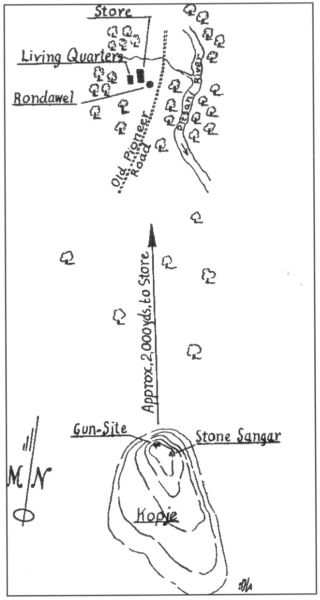
Rough, and in places, inaccurate, sketch map of the site of the battle
at Bryce's Store, Tuli Block, Botswana.
(Hickman, A S, Rhodesia served the Queen, Vol 1, 1970, P 39).
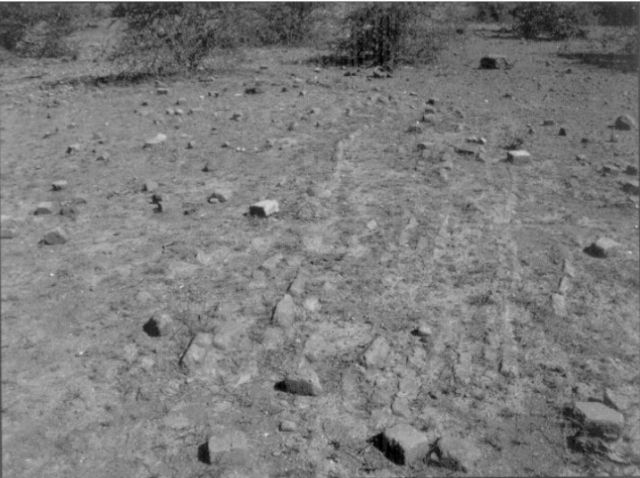
Present day remains of Bryce's Store which was demolished by Boer shelling,
November 1899, showing collapsed rear wall.
(photo: By courtesy, R Burrett, Zimbabwe).
The fight at Rhodes' Drift
Now let us consider the action at the nearby Rhodes' Drift Camp. When Colonel Spreckley received word of a fight at Bryce's Store, he took precautions at the drift. At about 13.00, the horses were brought in from grazing and fifteen men were posted in the thick bush on the low ground in front of the camp in the direction of Bryce's Store. Col Spreckley did not realise that he, too, was being surrounded. In this broken country, it was easy for the Boers to creep through the gullies around the small undulating ridge on which the camp was built and then attack it from all sides. (The photograph gives a general view of the site today). Once in position, the burghers opened fire, initially with the Maxim and rifles, and later, after the action at Bryce's Store, they brought the heavy artillery into play. The guns were positioned on a wooded kopje 800 yards (730m) to the north-west.
Thus began a constant bombardment that lasted from midday to sundown - nearly six hours. Some of the first shots hit the ambulance wagon, which was, fortunately, empty. Others were aimed at the animal lines, killing, maiming, or stampeding every horse and mule except one. The Rhodesians had to take cover and the many boulders on the kopje, and a big baobab tree at one end, afforded excellent protection. It is a wonder that there were no serious Rhodesian casualties.
At one point during the fighting, a white flag is said to have been raised by the Rhodesians and the Boers came out to take their prisoners. However, the Rhodesians then resumed firing and two burghers, G J van der Merwe and H Bong, were killed. Firing and shelling continued at a heated pace. At about 15.30, Col Spreckley sent a black runner to Fort Tuli with a message reporting his predicament and indicating that he intended to retreat that night. After dark, the Boers sent off a final volley, one shell landing in the camp, to which the Rhodesians replied firing randomly into the darkness. Thereafter, both sides settled into an unnerving silence. In fact, AssistantGeneral van Rensburg, rather than push the matter, retired for the evening with most of his men to their camp at Hendriksdal in the Transvaal. They took with them their dead and four injured men.
Being seriously outnumbered and outgunned, Col Spreckley decided to withdraw. The Rhodesians abandoned everything but their rifles. At 20.00 they quietly stole away, heading in single file north-east through a thorny and rock-strewn landscape in the black of night towards the Shashi River (now Shashe). Clearly Spreckley wanted to avoid the most direct, and obvious, route along the main road, believing that the Boers would have it heavily guarded. After a twelve-hour march, the Rhodesians reached the Shashi, and after a short break for breakfast (nothing other than water as they had no provisions), they trudged a further four hours upstream towards Fort Tuli, reaching a place known locally as 'Crocodile Pools', a few kilometres short of their destination. Here they were finally overcome with exhaustion and came to a halt - they had been fighting and marching for more than twenty-four unrelenting hours!
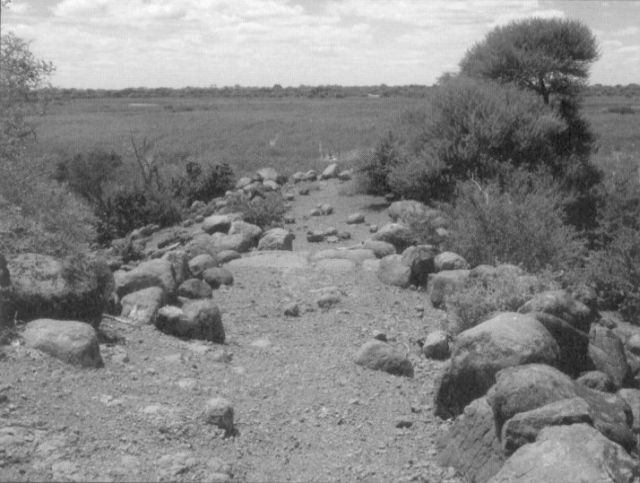
Eastern end of Rhodesian fortifications along the kopje near Rhodes' Drift
where Spreckley's men were surrounded in November 1899.
(Photo: By courtesy, R Burrell, Zimbabwe).
Meanwhile, back at Fort Tuli several patrols had been dispatched in various directions so as to ascertain what had happened. All of these patrols were unfruitful, although they did intercept several 'natives' who had escaped from Rhodes' Drift and who informed them that Spreckley's troop had been wiped out. General gloom settled over the Rhodesian forces. In the meantime, Glynn, using the only horse that 'E' Troop had secured in their flight, rode ahead of Spreckley's weary men to Fort Tuli to ask for help, arriving there at 10.25. In response, a delighted Major A F Pilson and the men of 'A' Troop rode out to Crocodile Pools, offering their horses to allow 'E' Troop to ride the remainder of the distance. Spreckley had returned with all his men, but he had lost his stores, a second military telephone, several wagons, and all of his horses and mules, although some of the horses that had stampeded in the heat of the battle, and which had not been captured by the Boers, later made their own way back to Fort Tuli.
Early on 3 November, the Boers returned to the Rhodes' Drift camp, but they were unaware that it had been deserted. They resumed shelling the ridge and this lasted for some time before they realised their error. For the Boers, the actions at Bryce's Store and Rhodes' Drift had been successful. They had captured much needed stores, a total of nine wagons, an ambulance, a cart, fifty-six horses, seventy-nine mules, and eighteen oxen, and they had driven the enemy from the Limpopo. Again they had the upper hand and would have been even more successful had they pushed on to Fort Tuli, but they again failed to seize the opportunity. Police Commandant Grobler felt he could take Fort Tuli and beyond with only 400 men, but his more senior officer, van Rensburg, was apprehensive, reiterating that they had insufficient supplies for an extended thrust. In addition, there was a general suspicion that the area had been extensively mined. Van Rensburg's decision prevailed.
In fact, the Boers soon took fright when, at about noon on 3 November, a rumour of a substantial Rhodesian counter-attack sent the men scurrying back to the Transvaal, abandoning their artillery and ammunition on Rhodesian soil. This panic followed the sighting of a huge cloud of dust that was seen approaching from the direction of Fort Tuli. The Boer commanders misconstrued this as the approach of a large Rhodesian column, but it was later found to have been a huge swarm of locusts. In the meantime, Native Commissioner D du Preez had a tough job trying to persuade some men to return to recover the guns.
So the two major skirmishes of the north-western front came and went. It had been a game of cat-and-mouse played across the frontier without real military tactics. The Boers may have won the day, but their failure to follow up cost them the war on this front. Divided councils and a lack of military nerve held back Boer initiative and it is very little wonder that the military leaders in Pretoria despaired of the weakness of their commanders along this frontier. Most were later recalled and sent elsewhere to the Cape and Natal battlefields were they were commanded by men of stronger will. In retreating as they did, the Boers left the north-western flank of the Transvaal Republic open, and Lieutenant-Colonel Plumer and the men of the Rhodesian Regiment could now redeploy towards the besieged Mafeking to recapture the occupied territories in Bechuanaland and the Cape Colony.
SOURCES
Two particularly useful additional references for the above part are the unpublished autobiographies of J J N D Potgieter (Swardt Family Collection) and A W Jarvis (National Archives of Zimbabwe, Historical Manuscripts. JA 4/1/2). As mentioned before, interested readers are advised to see the author's fully referenced articles on which this series is based:
Burrett, R S, 'Events in the Second Anglo-South African War, 1899-1902, in the wider Tuli Area, Zimbabwe-Botswana' in Heritage of Zimbabwe, No 18, 1999, pp 21-57.
Burrett, R S, 'The Far North-Western Front. Events in the Second Anglo-South African War in the Tuli Area, Zimbabwe-Botswana', unpublished report, 2001, held in the archives and library of the South African National Museum of Military History, Johannesburg.
Return to Journal Index OR Society's Home page
South African Military History Society / scribe@samilitaryhistory.org